Hanging lettuce garden no watering? Yes, you read that right! Imagine fresh, crisp lettuce readily available right outside your door, without the daily chore of watering. Sounds like a dream, doesn’t it? Well, get ready to wake up because this DIY project is about to make that dream a reality!
For centuries, humans have cultivated lettuce, with evidence suggesting its cultivation dating back to ancient Egypt. While traditional ground-based gardens are common, innovative approaches like hanging gardens have gained popularity, especially in urban settings where space is limited. Think of the Hanging Gardens of Babylon, one of the Seven Wonders of the Ancient World – a testament to the human desire to bring nature closer, even in the most challenging environments.
But let’s be honest, who has the time to water their garden every single day? Life gets busy, and sometimes our green thumbs suffer. That’s where this ingenious DIY trick comes in. This hanging lettuce garden no watering method is perfect for busy individuals, apartment dwellers, or anyone looking to simplify their gardening routine. Not only will you save time and water, but you’ll also have a beautiful and productive garden that’s sure to impress. I’m so excited to share this simple yet effective technique with you, so let’s get started and create your own self-watering lettuce oasis!
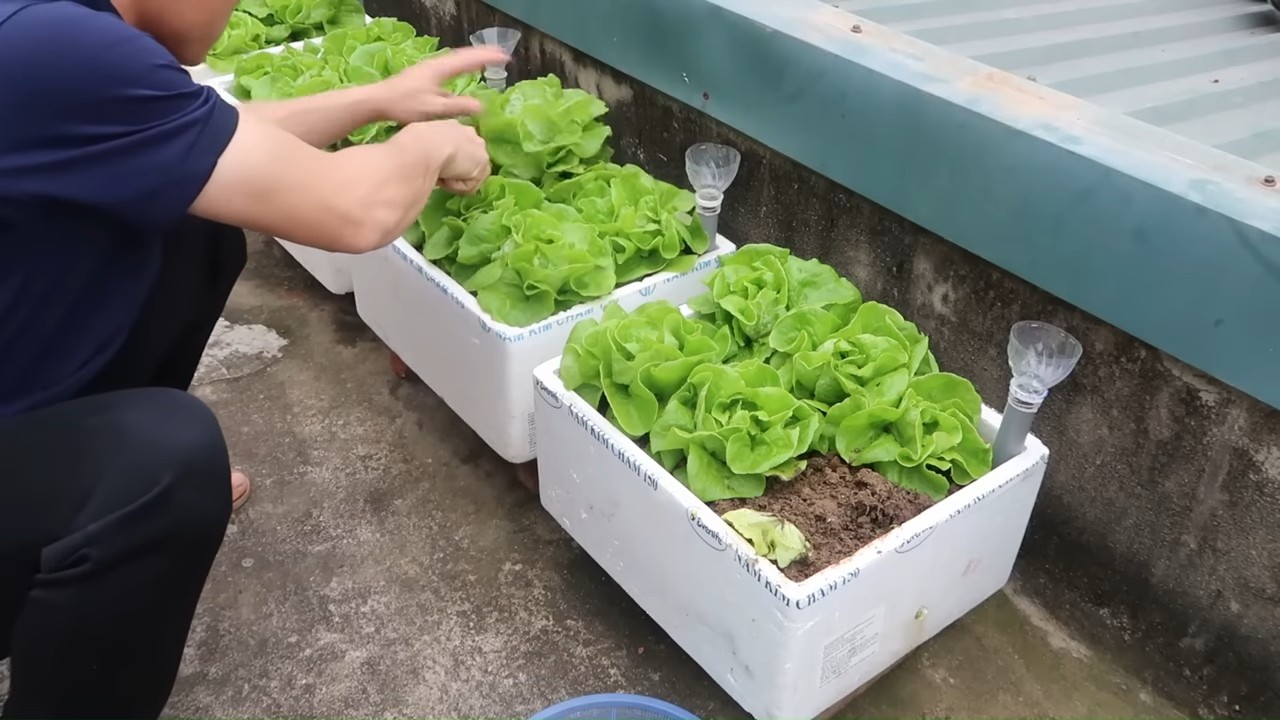
DIY Self-Watering Hanging Lettuce Garden: Never Water Again!
Hey there, fellow gardeners! Are you tired of constantly watering your lettuce, only to find it wilting in the summer heat? Or maybe you just don’t have a lot of space for a traditional garden? Well, I’ve got the perfect solution for you: a self-watering hanging lettuce garden! This project is surprisingly easy, budget-friendly, and will keep your lettuce happy and hydrated with minimal effort from you. Get ready to enjoy fresh, homegrown lettuce all season long!
What You’ll Need:
Before we dive in, let’s gather our supplies. Don’t worry, you probably already have some of these lying around!
* Two Plastic Buckets (5-gallon size is ideal): These will be our main containers. Make sure one bucket can nest inside the other.
* Drill with various sized drill bits: We’ll need this to create drainage and wicking holes.
* Utility Knife or Heavy-Duty Scissors: For cutting the fabric liner.
* Landscape Fabric or Burlap: This will line the inner bucket and prevent soil from washing away.
* PVC Pipe (1-2 inches in diameter, about 12-18 inches long): This will be our watering reservoir access point.
* Potting Mix: Choose a high-quality potting mix that retains moisture well.
* Lettuce Seedlings or Seeds: Pick your favorite varieties! I personally love a mix of romaine, butterhead, and red leaf lettuce.
* Measuring Tape or Ruler: For accurate measurements.
* Gloves: To protect your hands.
* Hanging Chain or Rope: To hang your beautiful lettuce garden. Make sure it’s strong enough to support the weight of the filled buckets.
* Optional: Decorative Paint or Stickers: To personalize your hanging garden!
Step-by-Step Instructions:
Alright, let’s get our hands dirty! Follow these steps carefully, and you’ll have your self-watering hanging lettuce garden up and running in no time.
1. Preparing the Outer Bucket (The Reservoir)
This bucket will hold the water reservoir that keeps our lettuce happy.
1. Drill Drainage Holes: Take one of your buckets (this will be the outer bucket). Using a drill bit (around 1/4 inch), drill several drainage holes in the bottom. About 6-8 holes should be sufficient. This is crucial to prevent the reservoir from overflowing during heavy rain.
2. Drill Hanging Holes: Near the top rim of the outer bucket, drill four evenly spaced holes. These holes will be used to attach the hanging chain or rope. Make sure the holes are large enough to accommodate your chosen hanging material.
3. Optional: Decorate the Outer Bucket: Now’s your chance to get creative! If you want to add some flair to your garden, paint the outer bucket with weather-resistant paint or decorate it with stickers. Let it dry completely before moving on.
2. Preparing the Inner Bucket (The Planting Container)
This bucket will hold the soil and our precious lettuce.
1. Drill Wicking Holes: Take the second bucket (the inner bucket). This is where the magic happens! Using a larger drill bit (around 1/2 inch), drill several holes in the bottom of the bucket. These holes will allow water to wick up from the reservoir into the soil. I recommend drilling at least 8-10 holes, spaced evenly across the bottom.
2. Drill Overflow Holes: About 2-3 inches from the bottom of the inner bucket, drill a few small overflow holes (around 1/4 inch). These holes will prevent the soil from becoming waterlogged if the reservoir gets too full.
3. Prepare the Fabric Liner: Measure the inside of the inner bucket. Cut a piece of landscape fabric or burlap that is large enough to line the entire inside of the bucket, including the bottom and sides. You want it to extend a few inches over the top rim.
4. Line the Inner Bucket: Place the fabric liner inside the inner bucket, making sure it covers all the drainage holes. This will prevent soil from washing out into the reservoir. Fold the excess fabric over the top rim of the bucket. You can secure it with a few dabs of hot glue if you want, but it’s not strictly necessary.
3. Assembling the Self-Watering System
Now we put it all together!
1. Insert the PVC Pipe: Place the inner bucket inside the outer bucket. Position the PVC pipe vertically in the center of the inner bucket, reaching down to the bottom of the outer bucket. This pipe will serve as our watering reservoir access point.
2. Add Potting Mix: Carefully fill the inner bucket with potting mix, working around the PVC pipe. Leave a few inches of space at the top of the bucket.
3. Water Thoroughly: Before planting your lettuce, water the potting mix thoroughly through the PVC pipe until water starts to drain out of the overflow holes in the inner bucket. This will help to saturate the soil and establish the wicking action.
4. Planting Your Lettuce
The fun part!
1. Plant Your Lettuce: Gently transplant your lettuce seedlings into the potting mix, spacing them according to the instructions on the seed packet or plant label. If you’re starting from seeds, sow them directly into the potting mix, following the instructions on the seed packet.
2. Water Again: After planting, water the lettuce seedlings or seeds gently through the PVC pipe to help them settle in.
3. Add Mulch (Optional): You can add a layer of mulch, such as straw or wood chips, around the lettuce plants to help retain moisture and suppress weeds.
5. Hanging Your Lettuce Garden
Time to elevate your garden!
1. Attach the Hanging Chain or Rope: Attach the hanging chain or rope to the holes you drilled in the outer bucket. Make sure the chain or rope is securely fastened and can support the weight of the filled buckets.
2. Hang Your Garden: Choose a sunny location for your hanging lettuce garden. Lettuce needs at least 6 hours of sunlight per day. Hang your garden from a sturdy hook or branch.
Maintaining Your Self-Watering Lettuce Garden
Congratulations! You’ve successfully created a self-watering hanging lettuce garden. Here are a few tips to keep it thriving:
* Watering: The beauty of this system is that you don’t have to water as often! Check the water level in the reservoir every few days by looking down the PVC pipe. When the water level is low, simply add water through the pipe until it starts to drain out of the overflow holes.
* Fertilizing: Feed your lettuce plants with a liquid fertilizer every few weeks, following the instructions on the fertilizer label. You can add the fertilizer directly to the water in the reservoir.
* Pest Control: Keep an eye out for pests, such as aphids or slugs. If you spot any, treat them with an appropriate organic pest control method.
* Harvesting: Harvest your lettuce leaves as needed, starting with the outer leaves. This will encourage the plant to produce more leaves.
* Sunlight: Ensure your hanging garden receives adequate sunlight. If you notice the lettuce is looking pale or leggy, try moving it to a sunnier location.
* Rotation: Periodically rotate the hanging garden to ensure even sunlight exposure on all sides.
* Winterizing: In colder climates, you may need to bring your hanging lettuce garden indoors during the winter months. Place it near a sunny window or under grow lights.
Troubleshooting
Even with the best planning, sometimes things don’t go exactly as expected. Here are a few common issues and how to fix them:
* Lettuce is Wilting: This could be due to several factors, including insufficient water, too much sun, or pest infestation. Check the water level in the reservoir, move the garden to a shadier location if necessary, and inspect the plants for pests.
* Soil is Too Wet: If the soil is constantly waterlogged, it could be due to clogged drainage holes or overwatering. Make sure the drainage holes are clear and reduce the amount of water you add to the reservoir.
* Lettuce is Not Growing: This could be due to poor soil quality, insufficient sunlight, or lack of nutrients. Amend the soil with compost, move the garden to a sunnier location, and fertilize the plants regularly.
* Pests: Regularly inspect your lettuce for pests. Common pests include aphids, slugs, and snails. Use organic pest control methods to eliminate them.
Enjoy Your Fresh Lettuce!
And there you have it! A beautiful, self-watering hanging lettuce garden that will provide you with fresh, delicious lettuce all season long. I hope you enjoyed this DIY project as much as I did. Happy gardening!
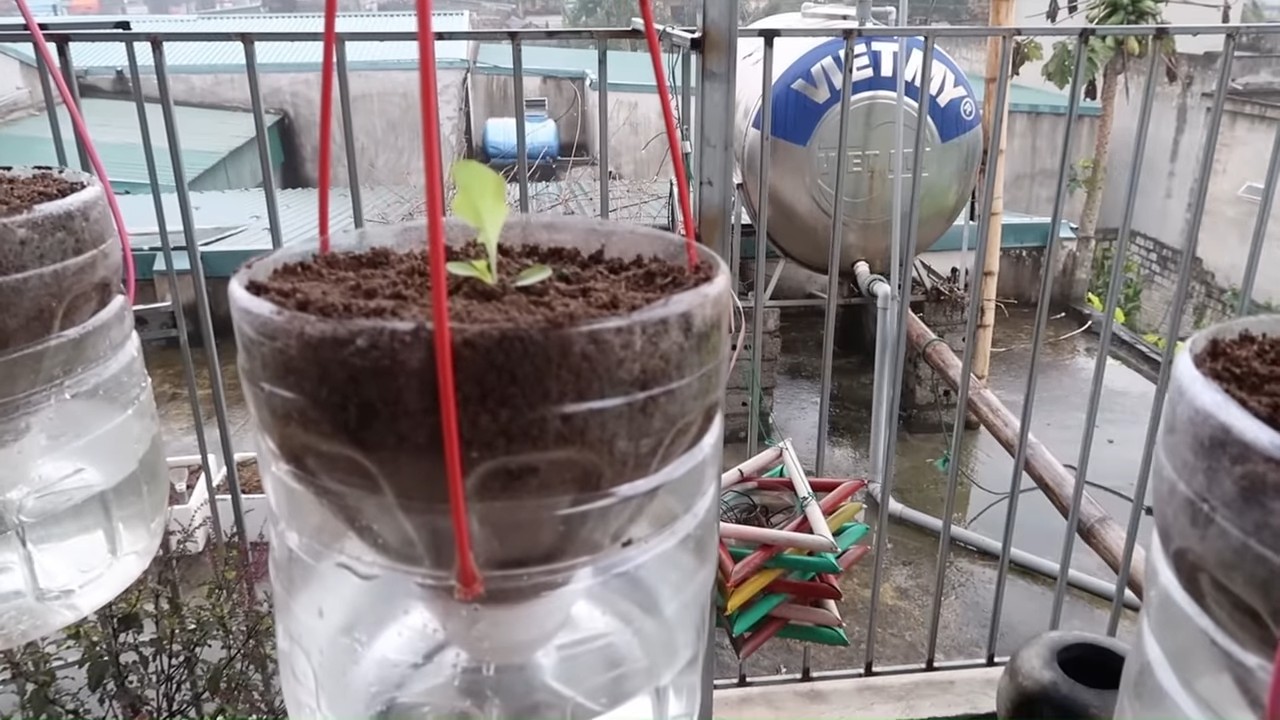
Conclusion
So, there you have it! Creating your own self-watering hanging lettuce garden is not just a fun project; it’s a game-changer for anyone who loves fresh, homegrown greens but struggles with space or time. Imagine stepping outside your door and snipping off the perfect amount of crisp, flavorful lettuce for your salad, sandwich, or wrap, all without the daily chore of watering. This DIY trick truly revolutionizes the way you can approach gardening, making it accessible and enjoyable for everyone, regardless of their gardening experience.
The beauty of this project lies in its simplicity and adaptability. While we’ve focused on lettuce, don’t feel limited! You can easily adapt this method for other shallow-rooted leafy greens like spinach, arugula, or even herbs like parsley and cilantro. Experiment with different varieties of lettuce to find your favorites – from the delicate butter lettuce to the crunchy romaine, the possibilities are endless. Consider adding companion plants like marigolds to deter pests naturally and add a splash of color to your hanging garden.
Furthermore, think about the location of your hanging garden. While it thrives in partial shade, ensure it receives enough sunlight for optimal growth. You might even consider rotating the hanging basket periodically to ensure even sun exposure on all sides. And for those living in colder climates, this system can easily be brought indoors during the winter months, allowing you to enjoy fresh greens year-round.
This self-watering hanging lettuce garden is more than just a gardening project; it’s a sustainable and rewarding way to connect with nature and enjoy the fruits (or rather, vegetables) of your labor. It’s a conversation starter, a beautiful addition to your outdoor space, and a constant source of fresh, healthy food.
We wholeheartedly encourage you to give this DIY trick a try. It’s a simple, cost-effective, and incredibly rewarding project that will transform the way you think about gardening. Don’t be afraid to get creative with your materials and personalize your hanging garden to suit your style and needs.
Once you’ve created your own self-watering hanging lettuce garden, we’d love to hear about your experience! Share your photos, tips, and variations in the comments below. Let’s build a community of gardeners who are passionate about sustainable and accessible food production. Your insights could inspire others to embark on their own gardening journey and discover the joy of growing their own food. So, get your hands dirty, embrace the process, and enjoy the delicious rewards of your self-watering hanging lettuce garden! Let us know how this **hanging lettuce garden no watering** method worked for you!
Frequently Asked Questions (FAQ)
What type of lettuce grows best in a hanging basket?
Almost any type of lettuce can be grown in a hanging basket, but loose-leaf varieties like Black Seeded Simpson, Salad Bowl, and Red Sails tend to be particularly well-suited. They are easy to harvest, grow quickly, and don’t require a lot of space. Butterhead varieties like Buttercrunch also do well, but may need a bit more space. Avoid head lettuce varieties like iceberg, as they require more room and may not thrive in a hanging basket environment.
How often do I need to refill the water reservoir?
The frequency of refilling the water reservoir depends on several factors, including the size of the reservoir, the type of lettuce you’re growing, the weather conditions, and the maturity of the plants. In general, you should check the water level every few days, especially during hot or dry weather. A good rule of thumb is to refill the reservoir when it’s about halfway empty. Over time, you’ll get a better sense of how quickly your plants are using the water and can adjust your watering schedule accordingly.
What kind of soil should I use for my hanging lettuce garden?
Use a high-quality potting mix that is lightweight, well-draining, and rich in organic matter. Avoid using garden soil, as it can be too heavy and compact, which can hinder drainage and root growth. A potting mix specifically formulated for containers is ideal. You can also amend the potting mix with compost or other organic materials to improve its fertility and water-holding capacity.
How much sunlight does my hanging lettuce garden need?
Lettuce prefers partial shade, especially during the hottest part of the day. Aim for at least 4-6 hours of sunlight per day. If you live in a hot climate, providing afternoon shade will help prevent the lettuce from bolting (going to seed) prematurely. If you’re growing your lettuce indoors, you may need to supplement with artificial light, such as a grow light.
How do I harvest lettuce from my hanging basket?
Harvesting lettuce from a hanging basket is easy! Simply snip off the outer leaves as needed, leaving the inner leaves to continue growing. This is known as “cut-and-come-again” harvesting and allows you to enjoy fresh lettuce for an extended period. Avoid harvesting more than one-third of the plant at a time to ensure it continues to thrive.
How do I prevent pests from attacking my lettuce?
There are several ways to prevent pests from attacking your lettuce. Companion planting with marigolds or basil can help deter pests naturally. Regularly inspect your plants for signs of pests, such as aphids, slugs, or snails. If you find pests, you can try hand-picking them off or using an organic insecticide, such as insecticidal soap or neem oil. Good air circulation can also help prevent pest problems.
Can I grow other vegetables or herbs in the same hanging basket as lettuce?
Yes, you can grow other vegetables or herbs in the same hanging basket as lettuce, as long as they have similar growing requirements. Good companion plants for lettuce include radishes, carrots, and herbs like parsley, cilantro, and chives. Avoid planting aggressive growers that might outcompete the lettuce for resources.
How do I fertilize my hanging lettuce garden?
Lettuce is a relatively light feeder, but it will benefit from regular fertilization. Use a balanced liquid fertilizer diluted to half strength every 2-3 weeks. You can also amend the potting mix with slow-release fertilizer granules at planting time. Avoid over-fertilizing, as this can lead to leggy growth and bitter-tasting lettuce.
What do I do if my lettuce starts to bolt (go to seed)?
Bolting is a natural process that occurs when lettuce is exposed to high temperatures or long days. Once lettuce bolts, the leaves become bitter and less palatable. To prevent bolting, provide afternoon shade, water regularly, and harvest frequently. If your lettuce does bolt, you can still harvest the seeds for future planting.
How long will my hanging lettuce garden last?
The lifespan of your hanging lettuce garden depends on several factors, including the type of lettuce you’re growing, the weather conditions, and your care practices. In general, you can expect to harvest lettuce from your hanging basket for several weeks or even months. Once the plants start to decline or bolt, you can replant with new seedlings or seeds.

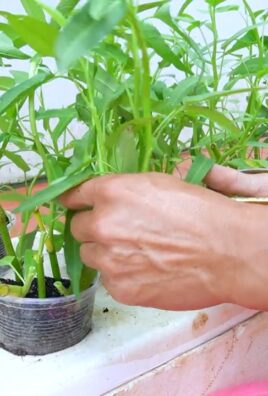
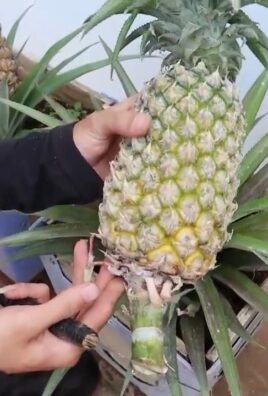
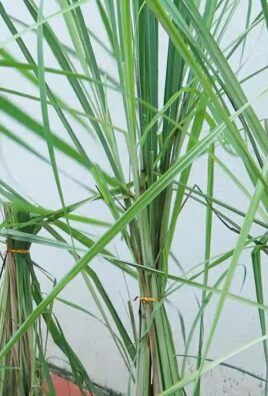
Leave a Comment